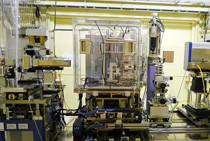
As evidenced by the 4th Science and Technology Basic Plan; the discussion of the promotion of green innovation technology in the 2012 White Paper on Science and Technology published by the Ministry of Education, Culture, Sports, Science and Technology (MEXT); the NEDO Energy Innovation Program; and the like, the commercialization and dissemination of fuel cells is a major policy issue for Japan, which has relatively few natural resources and energy sources and is faced with environmental challenges. There are great expectations for fuel cells as an advanced technology that will support the sustained development of Japan and Japanese society.
Polymer electrolyte fuel cells are a type of fuel cell with high power density and low operating noise. Thanks to these and other characteristics, these fuel cells are expected to be popular in fuel-cell vehicles, stationary cogeneration systems, portable power supplies, power supplies for information devices, emergency power supplies, and the like. Japan has achieved concrete research results in the field of polymer electrolyte fuel cells. For example, Japan pioneered the commercialization of household fuel cells. However, in preparation for the full-scale commercialization of fuel-cell vehicles from 2020 to 2030 and to enhance Japan's global competitiveness, Japan must improve fuel cell durability and reliability while reducing costs, and the development of fuel-cell technology is still one of the most pressing social issues facing Japan.

The main obstacle to the efficient design and development of new catalysts for next-generation fuel cells is the fact that the principles of the structures, functions, and catalysis of fuel cell catalysts are still not well understood from a scientific perspective. The only method for conducting in situ local structural analysis and electronic state analysis of the reactive metals (Pt, and the like) of actual fuel cell catalyst systems at the atomic level is X-ray absorption fine structure (XAFS) spectroscopy. This method is element selective.
The essential mission of the Innovation Research Center for Fuel Cells is using the new BL36XU beamline—which was constructed in SPring-8, is the only one of its kind in the world, and boasts the highest performance in the world—for in situ XAFS, time-resolved XAFS, and spatially resolved XAFS, and to thereby develop next-generation fuel-cell technology that will revitalize Japanese industry.
From May 1, 2010, to March 31, 2015
You can visit this site to view research introductions, etc.